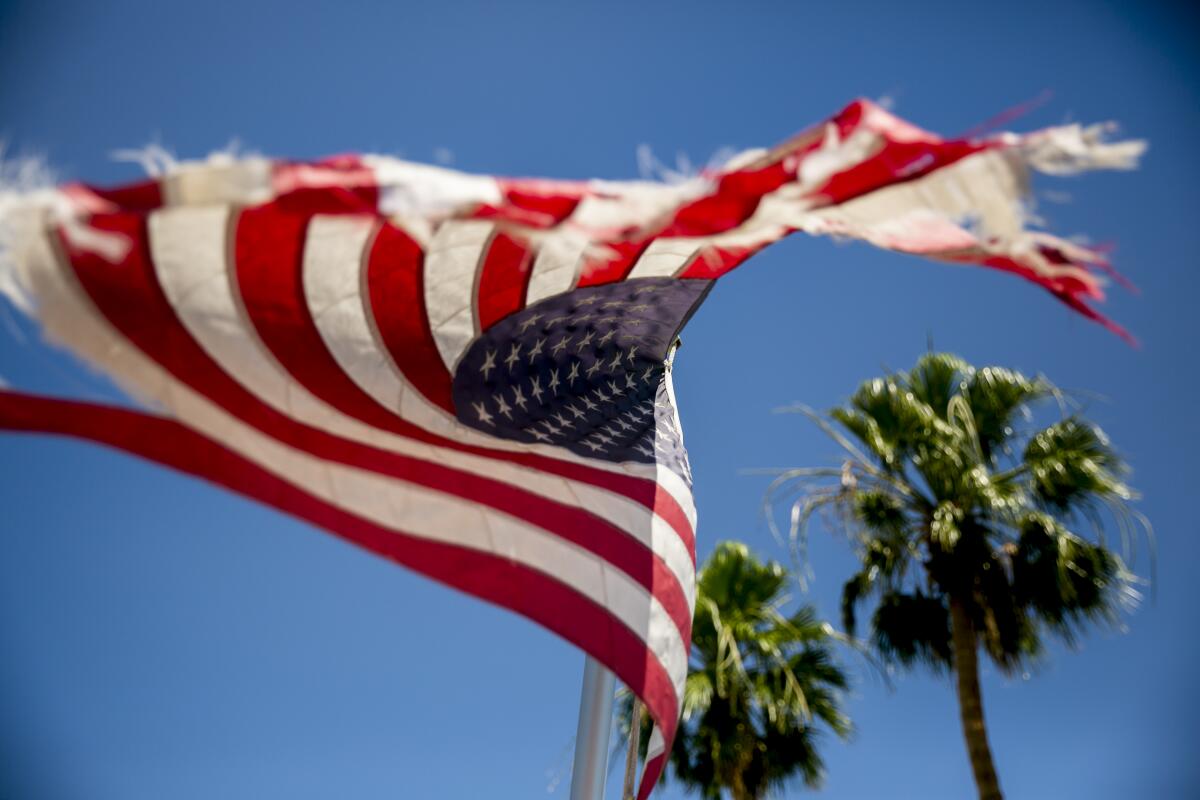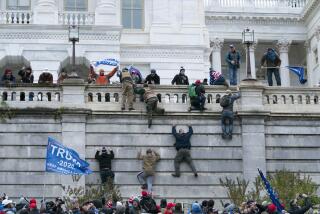American media wants to save democracy. Is it helping?

Earlier this year, the editors of the Journal of Democracy decided it was time for their no-frills intellectual magazine, published by Johns Hopkins University Press, to start publishing online.
At the time, Russia was gathering forces to topple the young democracy in neighboring Ukraine. Many Americans were still shaken by widespread efforts to overturn the 2020 election on behalf of Donald Trump. With democracy also faltering in many other countries around the world, the journal’s quarterly print schedule no longer seemed fast enough to keep up with reader demand.
“If I can’t convince you about the essentialness of wrestling with questions of democracy and authoritarianism today, when can I?” said co-editor Will Dobson. “There’s ample evidence that democracy is under stress today, and this is an opportune moment for us to expand our coverage.”
In recent years, an increasingly pronounced pro-democracy movement has been gathering strength inside U.S. media and the liberal intelligentsia as polls repeatedly show deep concern among the public about the future of America’s longtime system of self-rule. But not everyone is on board.
Top American journalism leaders have publicly argued that the continued existence of democracy in the U.S. is no longer something that can be taken for granted. Efforts to undermine voters’ choices across the U.S. have given way to new “democracy” beats, where newsroom editors and reporters no longer simply cover candidates and elections but voter registration laws, ballot access and election integrity.
Conspiracy theories and foreign election interference are now studied as “misinformation” or “disinformation” problems to be mitigated by social media platforms, by newsrooms and possibly even by government policy, lest the noise thwart voters’ democratic duty to make informed decisions.
“The battle for democracy is partly an intellectual battle,” said Larry Diamond, senior fellow at the Hoover Institution at Stanford University and a co-founder of the Journal of Democracy. “It’s an intellectual, cultural and moral struggle. It’s not just, people try a political system and hope it works, and it’s certainly not just a battle on the battlefield. It’s very substantially a battle of ideas, and norms and values.”
Liberal democracy as an international movement and a form of government has been on the decline globally since the 1990s, and American editors and writers have long had practice writing about autocratic governments gaining strength in countries like Vladimir Putin’s Russia and Viktor Orban’s Hungary.
“When you see democracies in distress, those that are willing to fight for their democracy or stand up for it, they’re going to come typically from certain pillars of political life,” Dobson said. “It is often the case that you see that type of activity and response coming from civil society, coming from academia, coming from student groups or from the press.”
The experience of other countries is feeding into how American democracy advocates interpret what’s happening in their own country. Earlier this summer, democracy experts at the organization Protect Democracy prepared a guide for American journalists titled “The Authoritarian Playbook: How reporters can contextualize and cover authoritarian threats as distinct from politics-as-usual.”
“The real assault on liberal democracy began in the last decade, and I think that it makes it especially important that citizens, that policymakers, diplomats, journalists know what to look for, know the warning signs of democracy in crisis, and know something about what it takes to save a democracy in crisis,” said Steven Levitsky, co-president of the Journal of Democracy’s editorial board, a professor of government at Harvard and one of America’s leading democracy scholars. “It feels like we’ve been in a world over the last five years where every week there’s an essay everyone has to read.”
The Atlantic magazine has been one of the key hubs for that sort of work; Pulitzer Prize-winning journalists such as Barton Gellman and Anne Applebaum raise concerns about the rising threats of single-party domination at home and abroad.
At the New York Times, which has formed a democracy team, new editor Joe Kahn recently declared, “You can’t be committed to independent journalism and be agnostic about the state of democracy.”
The normally strait-laced Associated Press has hired a democracy news editor. “We want to be really clear with people about the threats that we’re seeing to democratic institutions,” executive editor Julie Pace said last year on CNN’s “Reliable Sources,” whose host, Brian Stelter, has been prodding prominent media figures about how they’re covering what he has called the “assault on democracy.”
The Washington Post’s tagline, “Democracy Dies in Darkness,” adopted in 2017, was the newspaper’s first official slogan in more than a century of print journalism. The paper followed up with the creation of a democracy team, with a new emphasis on covering threats to election integrity, ballot access and rules-based government.
Post opinion columnists like Perry Bacon Jr. and Margaret Sullivan have argued for journalists to drop their usual both-sides coverage of politics to more directly cast pro-Trumpian election threats as a threat to the republic.
There are signs that some of those attitudes have also reached the newsroom rank-and-file. While 76% of American adults polled in a recent Pew Research Center study said that journalists should always strive to give every side equal coverage, a majority of journalists surveyed disagreed.
Andy Donohue, executive editor of projects for the publication Reveal at the Center for Investigative Reporting, who predicted the rise of the democracy beat in 2020, said in the journalism industry that there is “very broad recognition from everyone from newsroom leaders to reporters that we very much are in a red-alert threat for a real demise to our democratic system.”
“This isn’t Medicare expansion, where you get like, ‘the Democrats say and the Republicans say,’” Donohue said. “We can take the point of view that dismantling American democracy is bad, and start from that point of view and work backward.”
Some journalists have looked to America’s own past, including to the collapse of Reconstruction in the late 1800s, to contextualize how it’s possible for democratic rights to disappear in the U.S. under American institutions.
One of the most celebrated and contested journalism projects in mainstream media in recent years — the New York Times’ 1619 Project — was anchored around journalist Nikole Hannah-Jones’ argument that the U.S. wasn’t a democracy until Black Americans made it one through generations of successive struggle.
“More than any other group in this country’s history, we have served, generation after generation, in an overlooked but vital role: It is we who have been the perfecters of this democracy,” Hannah-Jones wrote in the project’s Pulitzer-winning essay. Hannah-Jones is now helping found a new Center for Journalism and Democracy at Howard University to help “produce journalists capable of accurately and urgently covering the challenges of our democracy with a clarity, skepticism, rigor, and historical dexterity that is too often missing from today’s journalism.”
But in newsrooms, in books and on the air, journalists and experts are openly pondering how American democracy can win the argument for its own survival when the battle of persuasion is with a public skeptical of their authority. Americans’ trust in newspapers and TV news is at an all-time low. Many Republican politicians have simply stopped talking to mainstream reporters, preferring the company of friendlier conservative outlets and personalities.
Some conservative journalists are skeptical that the “pro-democracy” attitude taken up by their legacy-media peers is just a permission slip to shoehorn liberal opinion into ostensibly nonpartisan coverage. After all, it’s Trump and his advocates inside the GOP who are seen as the radical threat to democracy, not the Democrats.
“Yeah, Trump made the lame ‘both sides’ posturing harder, because he is uniquely divorced from the truth and from decency,” Washington Examiner columnist Tim Carney wrote in a message to The Times. “But also, you know and I know that 90% of reporters and editors are in the leftmost 20% of the country on social issues, so it’s also just an excuse. Don’t like a conservative policy, call it ‘a threat to democracy’ and VOILA you don’t have to treat it fairly.”
Becket Adams, program director of the National Journalism Center, a program that trains conservative journalists, said he’s “leery of straight news initiatives that are pro- or anti- anything, even ‘democracy.’”
“News journalists need to focus on providing audiences with just the facts, rather than nudging them in the direction of a preferred viewpoint,” Adams said. “This means reporting fairly and impartially on both sides of a debate, and respecting audiences enough to interpret and analyze the information for themselves. They’re not children. If newsrooms want to speak out forcefully on certain issues, they always have the opinion section.”
The Society of Professional Journalists’ respected Code of Ethics, which stresses truth and fairness, announces its allegiance to self-government in its first line, declaring that SPJ members “believe that public enlightenment is the forerunner of justice and the foundation of democracy.”
But one of the journalists who helped write that pro-democracy language into the organization’s code of ethics for the first time in the 1990s is also not persuaded that pro-democracy advocacy is the wisest course for working journalists.
For the record:
8:28 a.m. Aug. 16, 2022A previous version of this article misstated the university affiliation of the Kiplinger Program in Public Affairs Journalism. It is at Ohio University.
“On one hand, as journalists we should be pro-democracy,” said former SPJ president Kevin Smith, executive director of the Kiplinger Program in Public Affairs Journalism at Ohio University. “We derive our press rights from that governmental structure, which is why it appears in the SPJ Ethics Code. We believe public enlightenment aids democracy. But to me that comes from accurate, fair and impartial news coverage. That’s what the code says.”
Smith likened the current American debate to journalistic practices he’s seen in South Korea in which the press often advocates for reconciliation on the peninsula with North Korea.
“Imagine getting to the point where we write every government story in which we advocate for democracy by labeling actions pro and anti based on our personal (or the publication’s) assessment,” Smith said. “That’s the slippery slope I am worried about.”
For experts like Levitsky, the struggle to mobilize constituencies in defense of democracy is a familiar one around the world.
“Democracy is not something that people get excited about when they have it,” Levitsky said. “It’s just a system of government. It doesn’t deliver all the great things in life, and I don’t think there’s any journal of ideas that could tell us otherwise. The one thing that we know that gets people excited about democracy is its absence.”
More to Read
The biggest entertainment stories
Get our big stories about Hollywood, film, television, music, arts, culture and more right in your inbox as soon as they publish.
You may occasionally receive promotional content from the Los Angeles Times.











